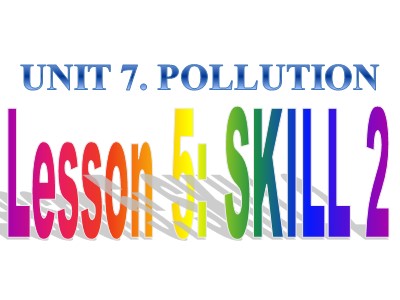Bài giảng môn Tiếng anh Lớp 8 - Unit 7, Lesson 6: Skills 2

2. Listen to part of a conversation on TV between a reporter and an environmentalist about thermal pollution. Complete the diagram. Use no more than three words for each blank.
Reporter: Does thermal pollution mean that bodies of water get hotter, Mr Nam?
Mr Nam: Not always. Sometimes the water becomes colder, and that’s also thermal pollution. In general, thermal pollution means a change in the water temperature. Reporter: That’s interesting! What causes it?
Mr Nam: Power stations are one factor. They use water in the nearby lakes or rivers to cool their equipment, which heats up the water. Then they dump the hot water back into its source.
Reporter: Are there any other causes?
Mr Nam: Yes. Thermal pollution may also happen due to the discharge of cold water from reservoirs into warm rivers.
Reporter: Thermal pollution can have dramatic effects. Right?
Mr Nam: Certainly. Most aquatic creatures need a certain temperature to survive. Warmer water has less oxygen in it, and this can harm fish populations. Besides, warmer water can cause harmful algal blooms. This can change the colour of the water like in the first picture and, more seriously, the algae poisons the fi sh. Reporter: What can we do, Mr Nam?
Mr Nam: In many places, they build cooling towers like in the second picture to cool down the water from power stations.
Reporter: Anything else we can do?
UNIT 7. POLLUTIONLesson 5: SKILL 21. Describe what you see in the pictures and talk about the relationship between them. They are both related to thermal pollutionThe first picture shows an algal bloom in coastal seawater. The second picture shows the cooling towers from a power station. Reporter: Does thermal pollution mean that bodies of water get hotter, Mr Nam? Mr Nam: Not always. Sometimes the water becomes colder, and that’s also thermal pollution. In general, thermal pollution means a change in the water temperature. Reporter: That’s interesting! What causes it? Mr Nam: Power stations are one factor. They use water in the nearby lakes or rivers to cool their equipment, which heats up the water. Then they dump the hot water back into its source. Reporter: Are there any other causes? Mr Nam: Yes. Thermal pollution may also happen due to the discharge of cold water from reservoirs into warm rivers. Reporter: Thermal pollution can have dramatic effects. Right? Mr Nam: Certainly. Most aquatic creatures need a certain temperature to survive. Warmer water has less oxygen in it, and this can harm fish populations. Besides, warmer water can cause harmful algal blooms. This can change the colour of the water like in the first picture and, more seriously, the algae poisons the fi sh. Reporter: What can we do, Mr Nam? Mr Nam: In many places, they build cooling towers like in the second picture to cool down the water from power stations. Reporter: Anything else we can do? 2. Listen to part of a conversation on TV between a reporter and an environmentalist about thermal pollution. Complete the diagram. Use no more than three words for each blank.2. CAUSES Power plants using water to (3) equipment - Discharge of cold water into (4) .1. Thermal pollution: - Definition: Water getting (1) or (2) .3. EFFECTS - (5) decreasing oxygen - Less oxygen harming (6) . - (7) .. algal blooms being another effect - Can change (8) of the water and (9) .. fish4. SOLUTIONS - Building cooling towers to (10) . the waterhottercoolercoolwarm rivers Warmer water fish populations Harmful colourpoisoncool down
Tài liệu đính kèm:
 bai_giang_mon_tieng_anh_lop_8_unit_7_lesson_6_skills_2.pptx
bai_giang_mon_tieng_anh_lop_8_unit_7_lesson_6_skills_2.pptx



